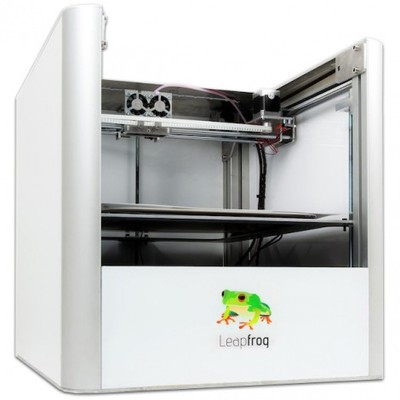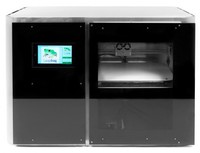Leapfrog offers not one, but two different low-cost 3D printers: the Creatr and the Xeed.
 First, let’s check out the Creatr. It’s a USD$1500 entry level personal 3D printer that is fully assembled out of beautiful laser-cut aluminum panels. It comes with a single extruder, but an alternate dual-extruder version is available for USD$1850. The machine consumes 1.75mm ABS, PLA or water-soluble PVA filament as its build material. The PVA is interesting, since when it’s used as the support material, any arbitrary shape can be successfully printed. The support material simply dissolves away to reveal the completed object. The Creatr also includes a heated print bed that should greatly assist printing ABS. The build envelope is a generous 250 x 270 x 300mm and the minimum layer thickness is 0.2mm for very fine prints.
First, let’s check out the Creatr. It’s a USD$1500 entry level personal 3D printer that is fully assembled out of beautiful laser-cut aluminum panels. It comes with a single extruder, but an alternate dual-extruder version is available for USD$1850. The machine consumes 1.75mm ABS, PLA or water-soluble PVA filament as its build material. The PVA is interesting, since when it’s used as the support material, any arbitrary shape can be successfully printed. The support material simply dissolves away to reveal the completed object. The Creatr also includes a heated print bed that should greatly assist printing ABS. The build envelope is a generous 250 x 270 x 300mm and the minimum layer thickness is 0.2mm for very fine prints.  The Creatr’s big brother is the Xeed, priced at USD$6700. For this much higher price you get many more features, including a standard second extruder. The Xeed also has a closed chamber that should help avoid ABS warping issues. We’re quite interested in seeing how the print cartridges operate, as you no longer have to fiddle with spools. The Xeed’s build size is larger as well: 370 x 340 x 290mm with a layer thickness of only 0.1mm. Unfortunately the Xeed will be available later this year and for now you can only place a deposit on your unit.
The Creatr’s big brother is the Xeed, priced at USD$6700. For this much higher price you get many more features, including a standard second extruder. The Xeed also has a closed chamber that should help avoid ABS warping issues. We’re quite interested in seeing how the print cartridges operate, as you no longer have to fiddle with spools. The Xeed’s build size is larger as well: 370 x 340 x 290mm with a layer thickness of only 0.1mm. Unfortunately the Xeed will be available later this year and for now you can only place a deposit on your unit. While the Creatr is perhaps similar to other units, the Xeed is more interesting, since it starts to intrude on Stratasys’s Mojo market. The Mojo, you’ll recall, is an ABS 3D printer priced at USD$10,000. The Xeed might produce similar results at a lower cost of machine and lower cost of materials, but it’s likely the Mojo has better operational features.
Via Leapfrog

